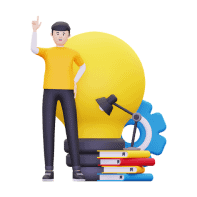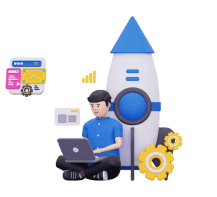What is a Sales Funnel? Everything You Should Know
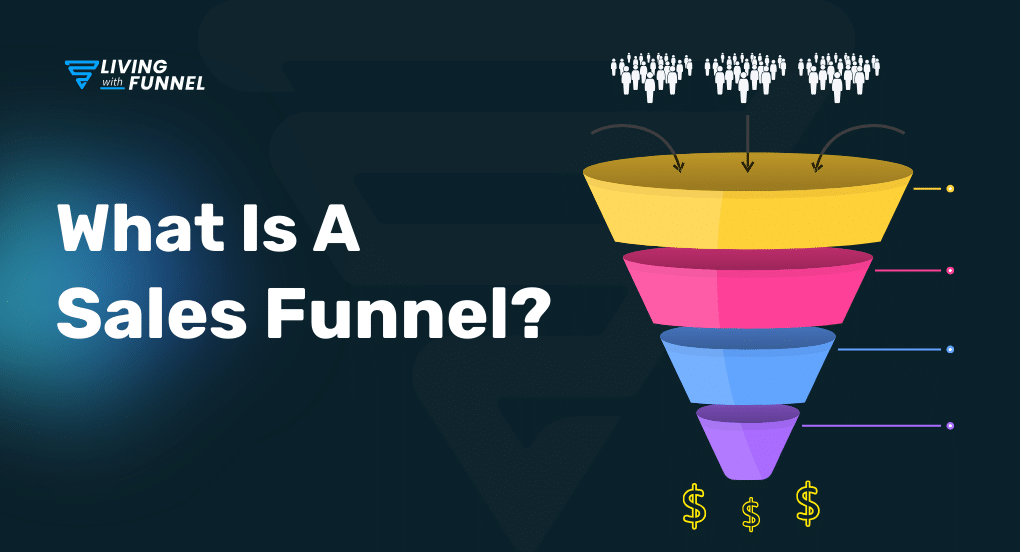
Fun fact: Every business, big or small, has its own sales funnel. Isn’t that interesting?
You could make a profitable, growing company online with a very sales funnel model – craft simple offers.
The downside is…
Nowadays, the word “funnel” is used in various contexts with different stages, making it so confusing.
- Sales strategy
- Marketing Plan
- A set of landing page
- Running Ads
- Content marketing
- The list goes on
But don’t worry, it’s easier than you think.
In this guide, we’re cutting through the jargon and revealing the simple truth about sales funnels.
By the end, you’ll know exactly how to use one to generate leads, boost your sales, and take key steps for business growth.
What Is A Sales Funnel?
The sales funnel is like a top salesperson, guiding your prospects through the entire sales process until they reach your desired destination.
The sales funnel stages depend on the company’s sales model, business goal, and context you use. But overall, it has 3 main elements:
- Top of funnel
- Middle of funnel
- Bottom of funnel
The sales funnel starts wide at the top and gets narrower at the bottom. The word “sales” in “sales funnel” refers to guiding consumers into becoming paying customers.
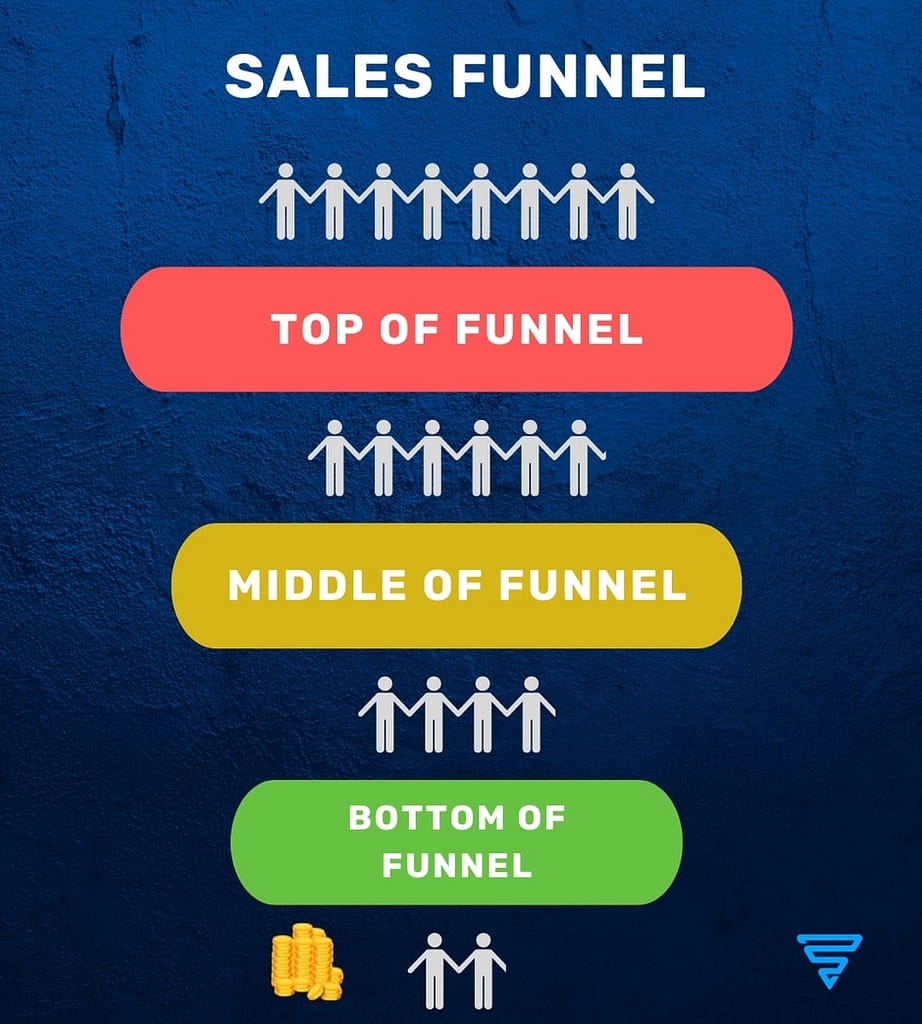
The higher up in your sales funnel people are, the less likely they are to make a purchase, as they are usually just becoming aware of your business or showing interest in a related topic.
On the other hand, as people move to the lower part of your sales funnel, they become more likely to make a purchase, as they are genuinely interested in buying.
The key takeaway is that only a percentage of people who enter your funnel will make a purchase.
Therefore, to boost sales, it’s crucial to have a strong sales funnel and enough people to start making sales.
How Does The Sales Funnel Works?
Let me tell you a quick story about when I started learning SEO & Affiliate marketing.
Like everyone else, I turned to YouTube and found a great channel called Matt Diggity that offers informative and entertaining videos.
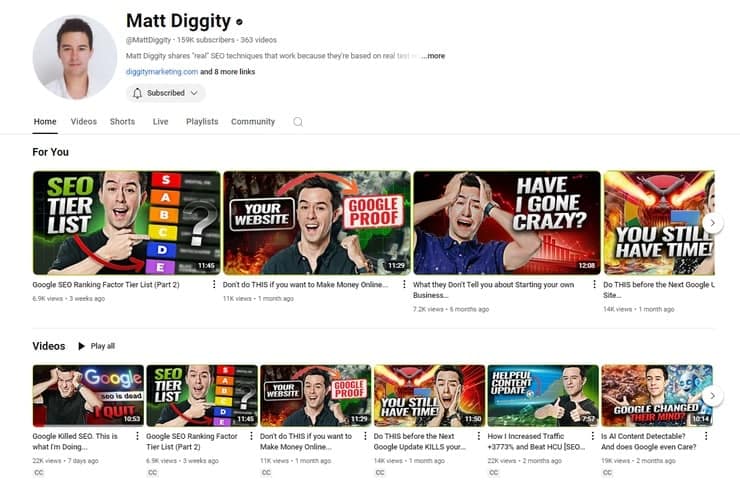
I decided to dig deeper and check out his blog to learn more.
To my surprise, he offered a free training course titled “Learn How To Be A Successful Affiliate SEO From Matt Diggity.”

After entering my contact information, I was directed to a thank you page, where he offered me a mini-course called “8 SEO Quick Wins that boosted traffic up to 280.11%” for just $10.
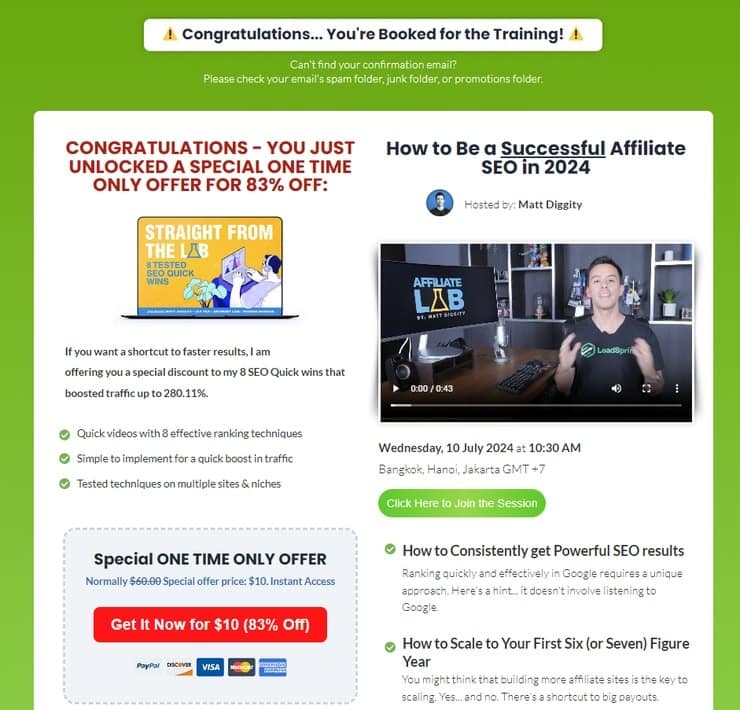
Even though I didn’t know much about him then, I was interested in the value he promised, and the course seemed like a great deal.
Moving on to the free training, shortly after, I received an email inviting me to join a webinar.
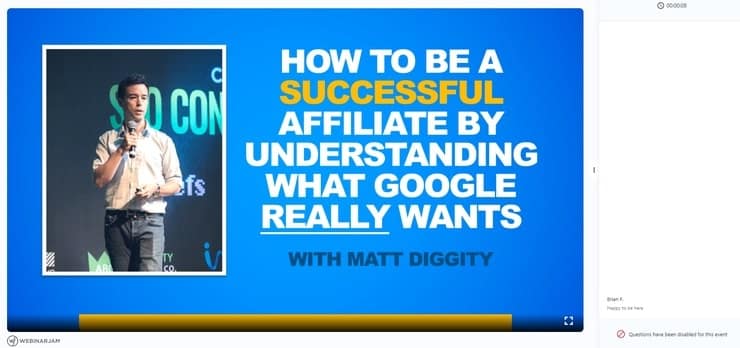
His training session was eye-opening, and at the end, he offered to join his Affiliate Lab program for $997.

While I was intrigued by the program, it was a bit more than I had planned to spend, so I decided to hold off for now.
But Matt didn’t give up there.
He kept targeting me with valuable emails and retargeting ads, knowing I was at the bottom of his sales funnel because my email address was on his list.

And to be honest, after 2 or 3 months of endless emails and social media interaction, I eventually bought his program, which is extremely valuable and worth it.
It’s how a simple sales funnel works.
💡 Bottom Line: Every business has its unique approach, but they all follow the same basic process. Each page in the sales funnel provides value and makes an offer that encourages visitors to move to the next stage of the process, ultimately guiding them to the business’s desired destination.
Why Is Sales Funnel Important?
There are several reasons why implementing a sales funnel is important, including the following:
- The customer has a better user experience: Each sales funnel is designed for a specific target audience and optimized based on their interests, pain points, and desires. It provides a clear Call To Action at each stage so that customers are not confused and can easily find what they are looking for.
- Increasing Average Cart Value (ACV): A well-designed sales funnel guides customers through different stages, allowing for strategic placement of upsells, downsells, and cross-sells. Tailoring offers to the customer’s specific needs and interests at each stage can significantly increase the average cart value and overall revenue.
- Build Your Own Distribution Lists: The primary goal of marketers is to convert visitors to their websites, whether from paid ads or organic traffic, into leads. With this list, you can send marketing messages whenever you want, like when releasing a new product, promoting something, sharing a new article, and more. This can lead to quick results at a low cost.
- Increase Customer Lifetime Value (CLV): Businesses can use sales funnels to guide customers from learning about the product to making repeat purchases. This helps build relationships, increase revenue, and improve the overall customer experience, leading to higher CLV.
- Easy to monitor and track: Each stage in the sales funnel is designed for a specific goal. So, if your funnel doesn’t convert as expected, you can easily track its performance, identify leaks, and fix them.
The 4 Core Sales Funnel Types For Generate Leads and Sales
Throughout my experience building sales funnels and working with different businesses, I’ve encountered many interesting variations and strategies for sales and marketing funnels.
I have identified 4 core types of funnels that are simple, effective, and suitable for various businesses.
💡 You don’t have to build all of them to succeed. Instead, focus on 1 funnel strategy, 1 offer, and 1 traffic source. Get it up and running quickly to see immediate results. Then, take the time to analyze and optimize it until it becomes profitable.
1. Lead Magnet Funnel
Ever wish you had a way to effortlessly attract potential customers for your business?
A Lead Magnet Funnel is like a matchmaker for your business, connecting you with potential customers. It helps you build trust, grow your list, and turn leads into loyal customers.
The journey begins with a simple step:
The potential customer lands on a page designed to capture their email address. This is usually done by offering a valuable freebie – think ebooks, whitepapers, or exclusive video series – in exchange for their contact information.
Once they’ve shared their email, they’re directed to a “Thank You” page.
The funnel might look like this.
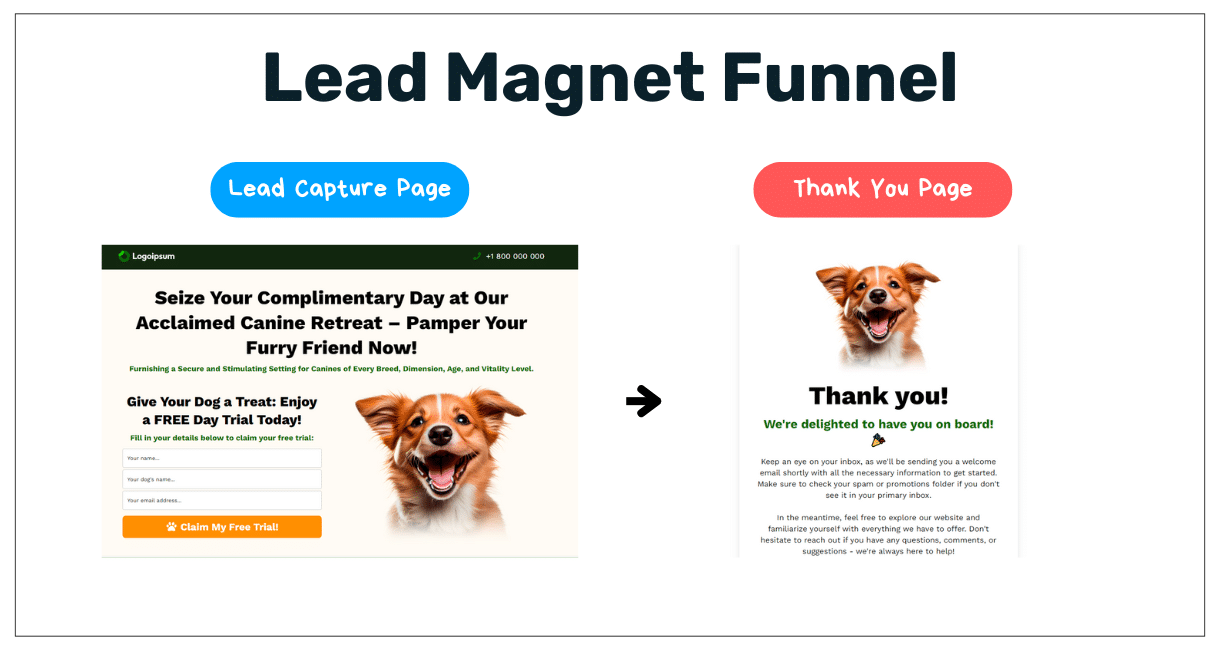
It’s really simple to create a lead magnet. Here are a few tips you can use.
- Keep it simple: Because you will create multiple lead magnets to attract your audience, it’s important to keep your process simple. Spending a month trying to build one, only to find it doesn’t work, means you’ve wasted a lot of time.
- Give it curiosity: Your lead magnet’s title or description should pique interest and make people wonder what’s inside. Use intriguing questions, bold promises, or hints at exclusive information to get people clicking.
- Focus on potential customer pain points: The most effective lead magnets offer a solution to a specific problem your target audience is facing. Consider their biggest challenges or frustrations and create a resource that directly addresses them.
💡 Want 106 PROVEN Lead Funnel Case Studies? Get this “go-to” swipe file that you can use for ideas for YOUR business.
2. Tripwire Funnel
A Tripwire is an irresistible, low-cost offer ($1 – $17) that sparks their curiosity and makes them eager to buy.
Once they experience the value of that first purchase, they’re primed and ready to discover more of what you have to offer.
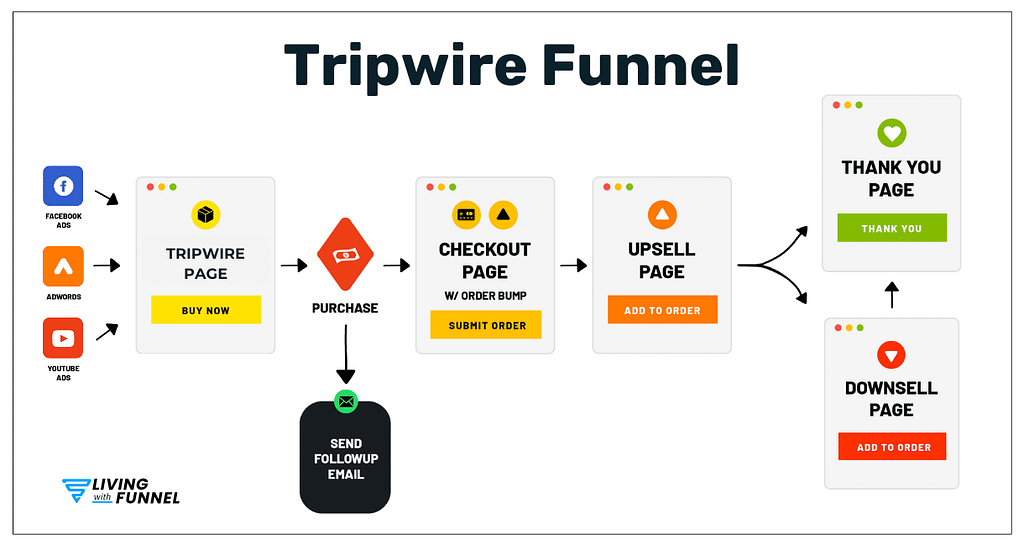
This is your chance to introduce them to your premium products – seamlessly through Order Form Bumps and One-Click Upsells or Downsales.
It’s a proven way to maximize their satisfaction and supercharge your sales.
Here’s what that might look like…
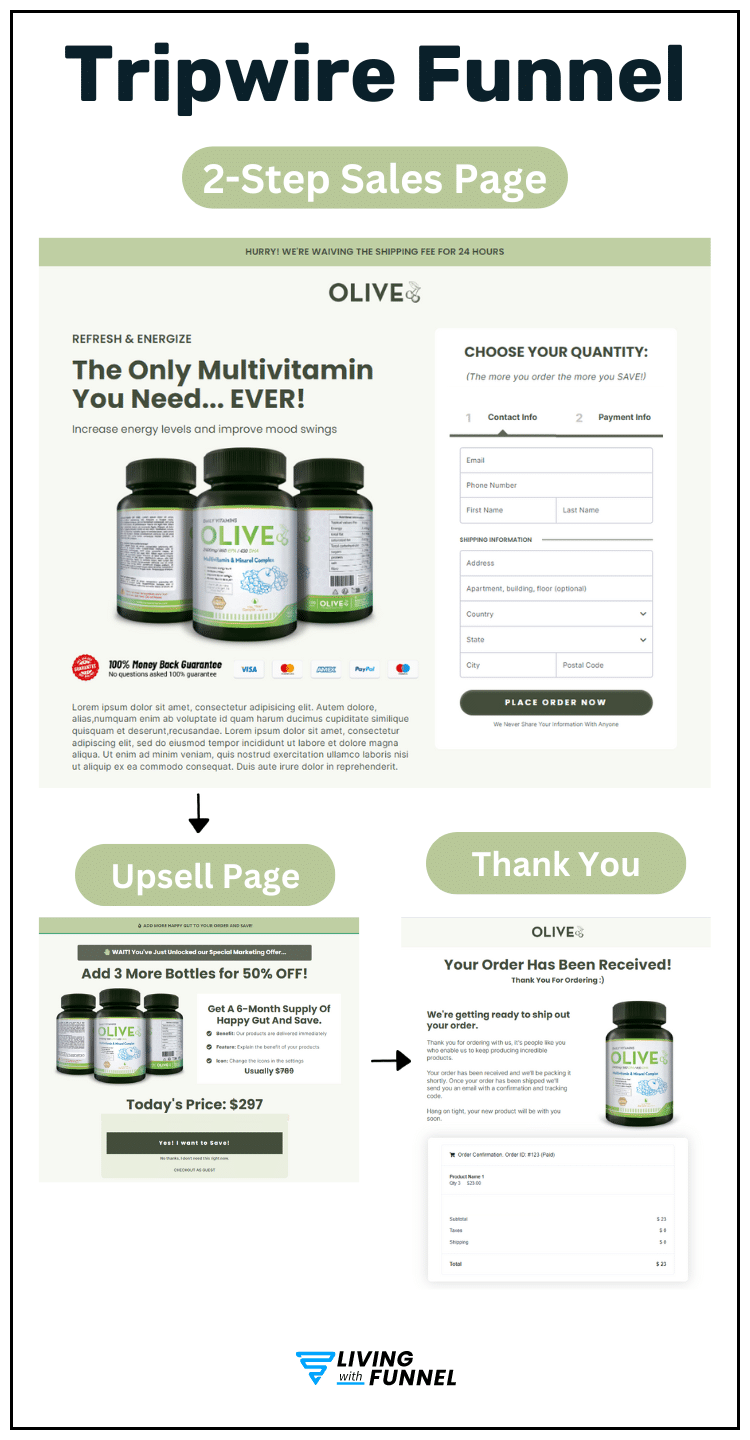
The entire sale process is really simple:
- Step 1: You’re asking potential customers’ contact information (name, email, address, phone number, etc)
- Step 2: Card information and customize the order. Here’s where you can add the Order Bump to increase the Customer’s Cart Value.
The cool thing about this 2-step order form is that even if people leave before completing their purchase, you still have their contact information.
This allows you to send email follow-up campaigns or retarget ads on Facebook or Google to remind them to return.
After a customer makes a purchase, we recommend other complementary items that complement what they bought—similar to a salesperson suggesting matching accessories.
This helps increase your sales.
Typically, our primary objective with this setup is to recoup the money spent on advertising. The real success comes when customers are satisfied with their initial purchase, as they are more likely to make future purchases from us.
3. Webinar Funnel
I recommend starting a Webinar Funnel if you’re a coach or course creator. Here’s why:
- Easier profits: Webinars help you make money right away. No more waiting!
- Perfect your pitch: Go live a few times to fine-tune your presentation and offers and find out exactly what your audience wants.
- Skyrocket conversions: With a great webinar, you’ll see incredible results.
Webinars are simple to set up and often get more people signing up than a regular squeeze page.
Here’s how a Webinar Funnel works:
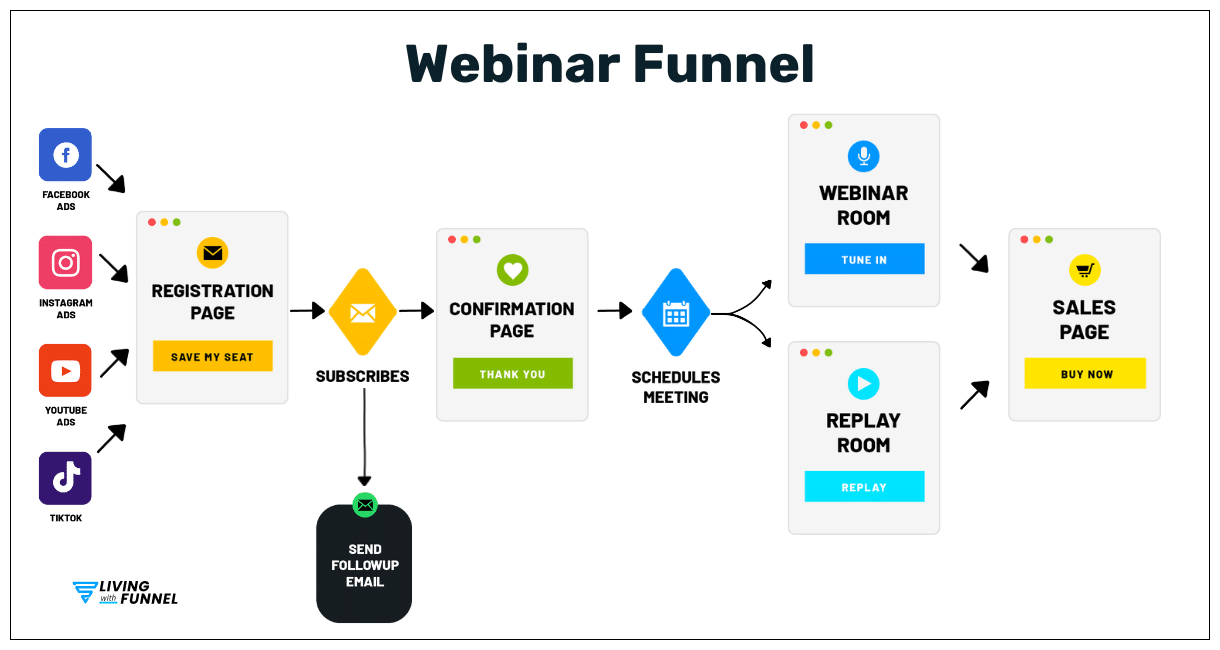
- Registration page: This is where people sign up for your webinar. Make it exciting so they can’t wait to join!
- Confirmation/Thank You Page: Don’t just say “thanks.” Offer something enticing! A special low-priced offer or a free trial can cover ad costs and get them invested. Remember, if they buy before the webinar, they’re way more likely to show up and buy again!
- Live Webinar or Replay Page: This is where the magic happens! Deliver incredible value and connect with your audience.
- Sales page: Make your offer irresistible. Show how your product or service will solve their problems and transform their lives.
Here’s what that Webinar Funnel might look like…
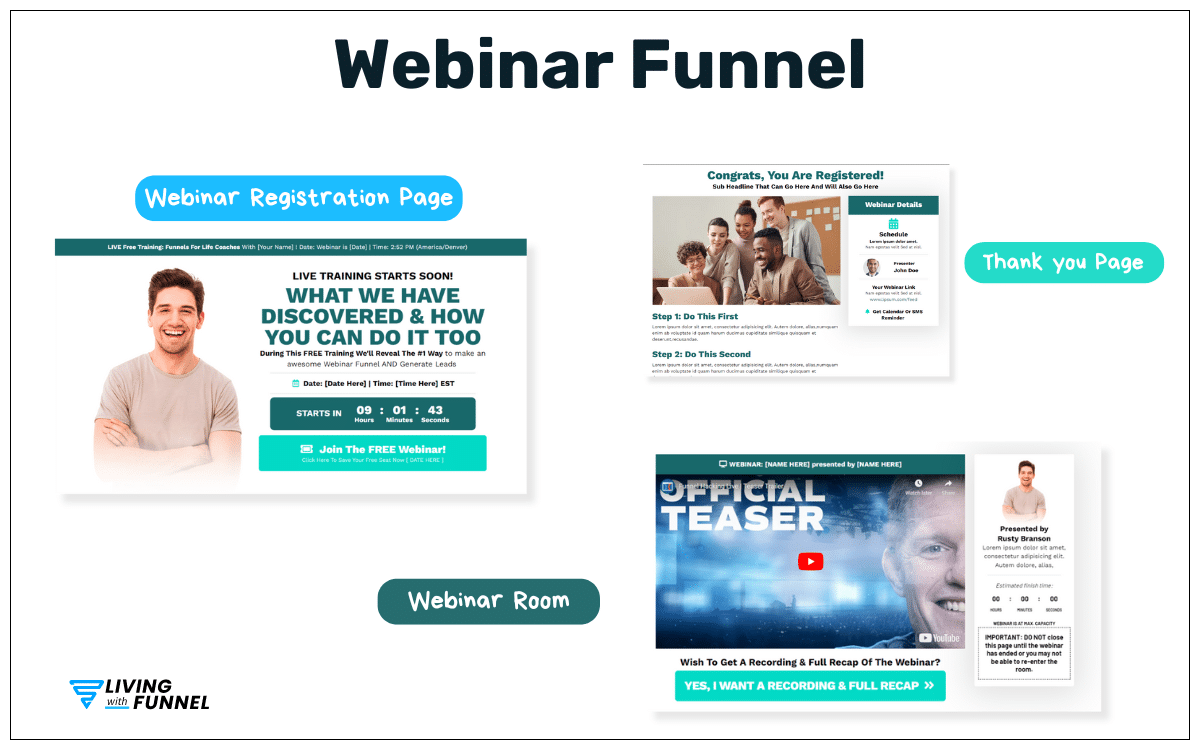
💡 Want to get the simple and proven scripts that help you create webinar presentations that SELL? Check it out!
4. Application Funnel
An application funnel is a special way to sell more expensive things, like courses or coaching programs. It’s not just about getting many people to sign up but finding the right people interested and ready to buy.
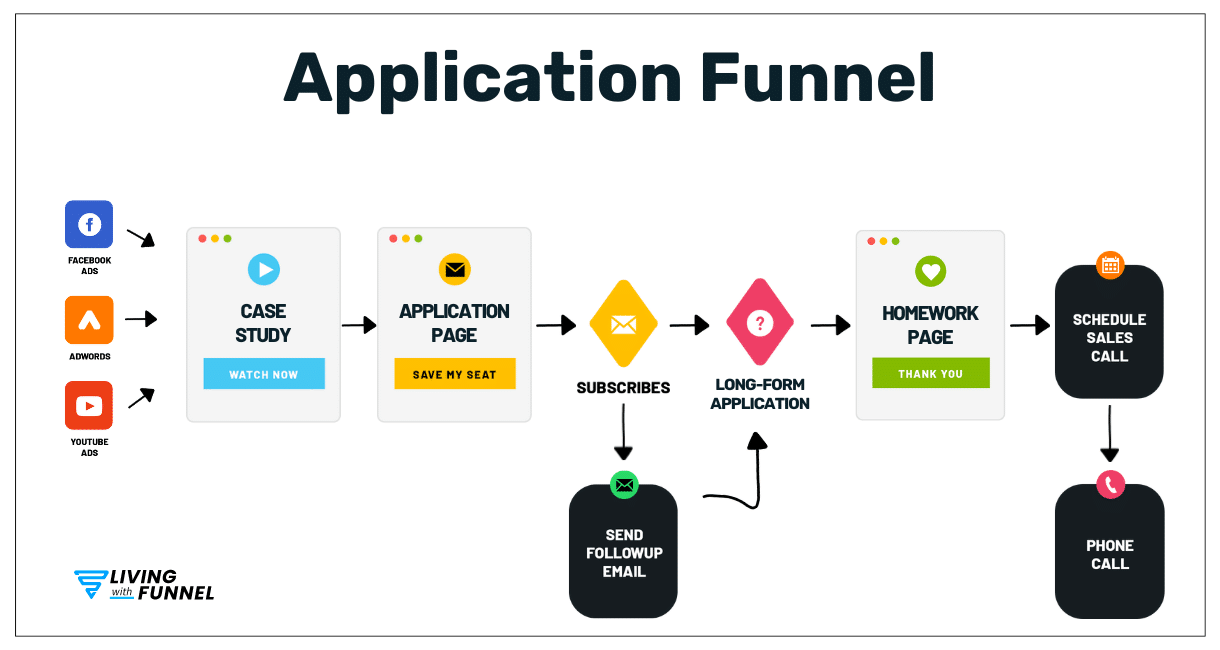
Here’s how the Application Funnel works:
- Case Study Page: First, you show your potential customers a cool story about someone who worked with you and got amazing results. This gets them excited about what you can do for them, too!
- Application Page: This is where they sign up. It’s a two-step process. In step one, we only collected email addresses, allowing us to follow up with them in case they do not complete step two—the long-form application.
- Homework Page: Here, you get to know your potential customers better. Tell them what to expect, give them some fun tasks, and schedule a phone call.
- Call & Close: This is where the magic happens! You (or your sales team) make a phone call with them, answer their questions, and close.
Here’s what that Application Funnel might look like…
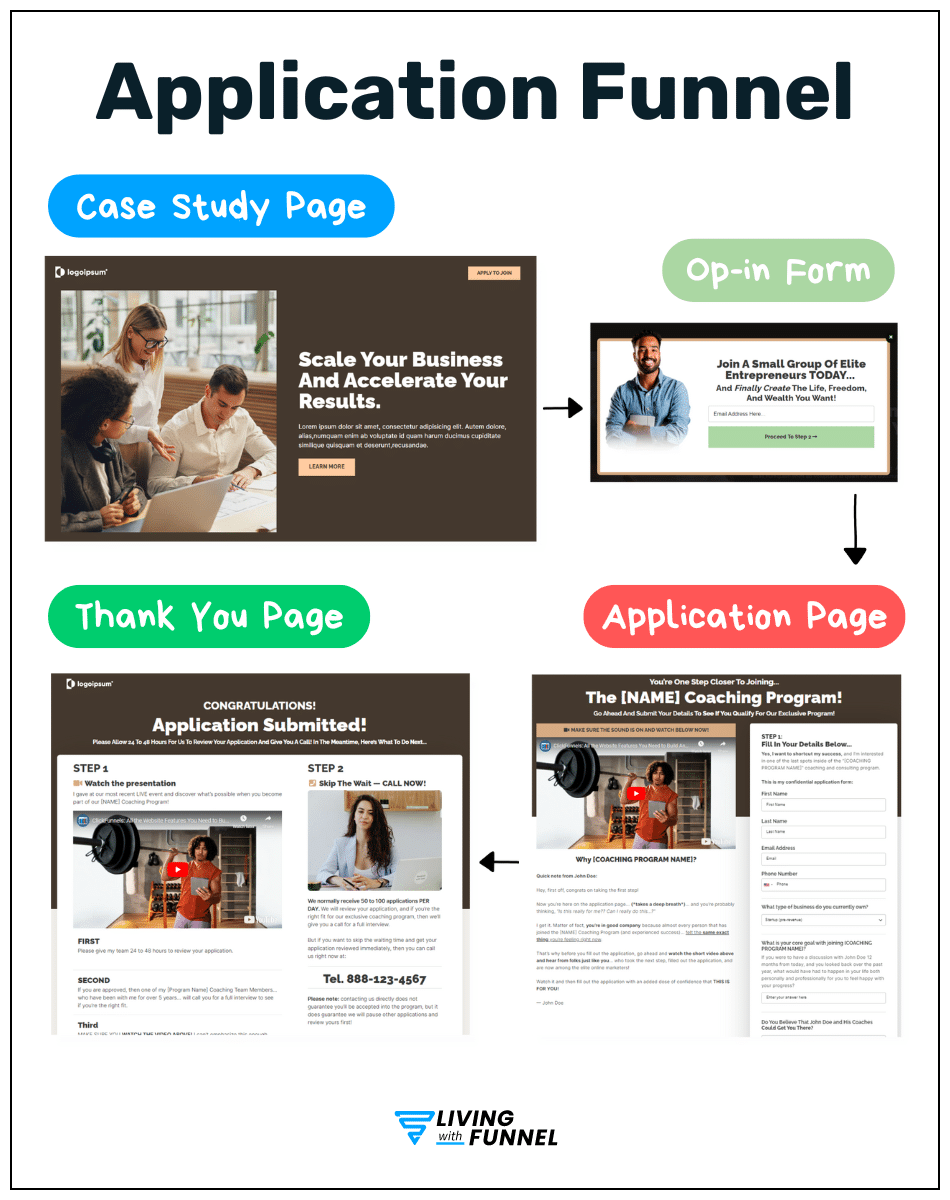
If you offer high-end coaching or services over $2,000, an Application Funnel might be your secret sauce!
It’s perfect for businesses that thrive on custom solutions, in-person meetings, B2B, or a good old-fashioned phone call before someone says yes.
Why?
An application funnel attracts the right kind of clients who are truly invested in their success and ready to take action.
It’s like a VIP pass to your exclusive club, so everyone who joins is a perfect fit for your unique offerings.
💡 I recommend you read the Dotcom Secrets book to unlock the full potential of your application funnel and get proven scripts that can supercharge your phone conversions and skyrocket your sales
How To Create A Sales Funnel?
1. Identify Your Target Customers
You CAN NOT create a successful sales funnel without knowing your dream customer inside and out. Because:
Try to sell to everyone – It’s like hitting a target with your eyes closed. You’re wasting time, money, and energy on people who will never buy.
Instead, identify your ideal customer.
Get crystal clear on their demographics, psychographics, and behaviors. Then, build your entire sales funnel around them.
Here are four simple steps to identify target customers:
- Step #1: Identify Long-term Desire and Immediate results they want
- Step #2: List Problems they need to solve and the #1 pain point that frustrates them
- Step #3: List questions they need to answer so they can move forward
- Step #4: The #1 objection or roadblock that prevents your ideal customers from moving forward
For example,
My ideal customer is Alex.
Alex is an overworked person who dreams of becoming healthy. Currently, Alex’s focus is on Physical transformation.
Ultimately, Alex really wants to Transform. [#1 Long term desire]
Right now, he would be ecstatic if he could gain muscle. [Immediate results] Unfortunately, Alex still needs to figure out how to develop a consistent fitness routine and healthy eating habits. [Problems]
Alex is also really frustrated by the fact that feeling stuck in a cycle of failed attempts at getting fit. [Pain Point]
Plus, He still needs the answer to this question before He can move forward: “How can I finally achieve my fitness goals and stick with them long-term?” [Question]
Alex is also still hung up on the idea that he doesn’t have enough time to commit to a gym membership and a healthy lifestyle. [#1 Roadblock/Objection]
In fact, when it comes to Physical transformation, he is convinced that inconsistent motivation, unhealthy habits, and a lack of time actually want him to fail. [Problems]
When all is said and done, Alex wants to feel confident and comfortable in their body, enjoying a healthy and active lifestyle. [Result]
Researching and creating your first customer avatar may require some effort, but the results are definitely worth it!
💡 Need help creating customer avatars quickly? Check out Funnel Scripts. You can watch the video demo here.
2. Craft Your Offer
No matter if you’re selling courses, coaching, consulting, or physical products
You need an offer message that stops your perfect customer in their tracks and makes them think, “Yes! This is EXACTLY what I’ve been looking for.”
Your power offer is like your elevator pitch for your product or service.
Get it right, and it’ll immediately separate the freebie hunters and casual browsers from the eager buyers, helping you find and connect with the people ready to dive in.
Follow my simple strategy to create an irresistible offer:
- In-Depth Competitive Research: Take a deep dive into your top competitors’ offers. Analyze their pricing, packaging, bonuses, guarantees, and overall value proposition. Look for patterns, commonalities, and unique selling points.
- Uncover the Gaps and Missed Opportunities: Delve into customer feedback, online forums, and social media discussions to uncover unmet needs, and emerging trends that your competitors haven’t addressed.
- Craft Your Solution – Fill the Gaps and Exceed Expectations: Design your offer to address specific pain points and unmet needs. Aim to exceed customer expectations by offering unique features, superior quality, or exceptional customer service that set your offer apart from others.
Example Offer:
“The Total Body Transformation Package”
- 12-Month Gym Membership: Unlimited access to state-of-the-art equipment and facilities.
- Personalized Training Plan: Designed to meet your specific goals and fitness level.
- Weekly Nutritional Coaching: Expert guidance on healthy eating habits for optimal results.
- Unlimited Group Fitness Classes: Variety and fun to keep you motivated.
- Exclusive Online Portal: Access workouts, meal plans, and community support from anywhere.
- 30-Day Money-Back Guarantee: If you’re not satisfied, we’ll refund your membership fee.
Limited Time Bonus: Sign up today and receive a FREE fitness assessment and a personalized workout gear starter kit!
3. Pick A Funnel Strategy
Choosing the right funnel strategy depends on your business goals, target audience, product or service, and available resources.
Here’s a breakdown of how I pick a funnel strategy based on product price.
| Price | Types Of Funnel |
|---|---|
| Free | Lead Magnet Funnel |
| From $7 to $27 | Tripwire Funnel |
| $27 – $297 | Sales Letter/ Video Sales Letter Funnel |
| $297 – $2000 | Webinar Funnel |
| Over $2000 | Application Funnel |
A Video Sales Letter Funnel typically involves a higher-cost offer, while a Tripwire Funnel starts with a low-cost, irresistible offer to attract potential customers.
However, the overall work plan for the funnels is similar.
4. Build Your Sales Funnel’ Pages
It’s time to create impactful landing pages within your sales funnel.
If you’re not very tech-savvy or don’t have design skills, I suggest using ClickFunnels or Systeme.io.
These platforms are designed specifically for funnel building, making it easier for you to create funnels.

They offer tools, analytics, and automation that can help guide visitors through a targeted conversion path and achieve your business goals.
For WordPress users who prefer more control, Thrive Suite paired with a third-party email marketing platform like Getresponse or Moondsend is also a great option.
5. Write Your First Email Follow-up Campaign
The first email follow-up sequence is like the start of a new friendship.
Keep it simple and friendly, like you’re talking to a friend. Let them know who you are and why they should stick around.
Watch the video below, Sabri Suby sharing his secrets for the perfect follow-up plan. He’ll even show you some common mistakes that might stop people from buying.
Here are some easy writing tips to make your emails pop:
- Short and Sweet: Keep your sentences short, just one or two per line. It’s easier to read that way.
- Show Your Style: Let your personality shine through. Be fun, be real, be YOU!
- Speak to their Feelings: Connect with how they feel about the problem and show them how your product is the answer.
- Prove It Works: Use logic and facts to explain why your product rocks.
- Add a Little FOMO: Make them feel like they’ll miss out on something great if they don’t buy.
💡 Another email marketing strategy is the “Soap Opera Sequence.” This strategy keeps people hooked like a TV show!
6. Make It Rain
It’s time to launch your sales funnel.
First: Double-check all steps. Make sure every link works. Each stage should flow smoothly.
Next, test the funnel yourself. Click through each step. Fix any snags.
Getting stuck? Ask for help. Have a friend or colleague try it out. They can spot issues you missed.
Remember, these are the early days.
Revise based on data. Improve weak points. Make tweaks.
Celebrate small wins. Each improvement brings you closer to a perfect funnel.
Going live can feel like a big leap. Trust in your work. You’ll learn and grow from here.
Key Sales Funnel Metrics To Consider
We gathered 9 important funnel metrics you should focus on in your sales funnel.
- LEAD: The lifeblood of any funnel, these are potential customers entering the top.
- Cost Per Click & Cost Per Lead (CPC & CPL): We track these costs closely to ensure our ad spend effectively attracts quality leads.
- Customer Acquisition Cost: Knowing how much it takes to acquire a customer helps us optimize our marketing budget.
- Customer Lifetime Value (CLV): This metric is pure gold – understanding the long-term value of a customer guides our entire funnel strategy.
- Cost Per Action (CPA): We aim to lower this cost constantly to maximize our return on investment.
- Average order value (AOV): Increasing average order value is key to boosting revenue, so we always look for upsell and cross-sell opportunities.
- Return on Ad Spend (ROAS): This metric tells us how well our ad campaigns perform and where to allocate resources.
- Abandonment & Churn Rate: By identifying leaks in our funnel, we can patch them up and improve customer retention.
- Traffic Reinvestment: We strategically reinvest some of our revenue to drive more traffic and scale our business.
By constantly monitoring and optimizing these metrics, we ensure our sales funnels are well-oiled machines, generating leads, converting customers, and maximizing profits.
Tips for Optimizing Your Sales Funnel
Once your sales funnel is complete, it’s time to optimize it.
Think of your sales funnel as a treasure map. We want your customers to easily find the X marks the spot (the buy button!).
First, sketch your funnel map. What steps do customers take from “just browsing” to “I’ll buy it!” This will help you know where to put signs (like cool ads or helpful emails).
Make those signs eye-catching!
Use “Shop Now” or “Get Yours Today” to get people clicking. Your website should look awesome, too. Keep it simple, with clear pictures and easy-to-find info.
Don’t be afraid to experiment!
Try different signs or paths and see which ones lead to more treasure (sales!). For small shops, sending friendly, automatic emails keeps customers on track.
A/B Testing
A/B Testing helps you learn what your customers like.
Maybe they prefer a red button over a blue one or a shorter headline.
With A/B testing, you can make small changes that lead to big improvements in your sales.
Here’s how it works:
- Create two versions: Take a webpage, an email, or even an ad, and make a small change to one version. It could be a different headline, a new button color, or anything you think might make a difference.
- Show both versions: Let some people see the original and others see the new one.
- See which wins: Track which version gets more clicks, sign-ups, or sales. That’s the winner!
Key tip: Only change one thing at a time. That way, you’ll know exactly what caused the improvement.
Keep testing! Customers change, so what works today might not work tomorrow. By testing regularly, you’ll always be one step ahead.
Analyzing Customer Feedback
Listening to your customers is crucial for improving your sales. They can tell you what’s working and what’s not so you can make things even better!
How to get feedback:
- Ask them directly: Send surveys or have your sales team chat with customers.
- Read their reviews: Check out what people are saying online.
- Pay attention to support: Keep track of customer questions or problems.
What to look for:
- Are there any common problems? Maybe lots of people are confused about the same thing. If so, you can fix it to make things easier.
- What do they love? Find out what’s working great, and do more of that!
Remember: Feedback isn’t just about fixing problems. It’s also about getting to know your customers better. What do they like? What do they need? When you understand them, you can make your sales process a perfect fit.
Continuous Improvement
The best sales strategies are always changing. To stay ahead, you must watch what’s working and what’s not.
- Track your progress: Pay attention to how many people move from one step to the next in your sales process. This helps you see which parts are working well and which need help.
- Find the weak spots: Notice a sudden drop in interest? That’s a clue that something needs fixing. Maybe your message isn’t clear, your prices are too high, or your customer service requires a boost.
- Remember: You don’t have to change everything at once. Small improvements over time can make a big difference.
- Keep learning and adjusting: By checking your data, listening to feedback, and making smart changes, you can keep your sales rising!
Frequently Asked Questions
Here are answers to some of the most frequently asked questions about the sales funnel.
What is the difference between a sales funnel and a marketing funnel?
The key difference between a sales funnel and a marketing funnel is that a marketing funnel focuses on generating awareness and interest, primarily attracting potential customers and nurturing leads.
In contrast, a sales funnel covers the entire customer journey, including conversion and post-purchase strategies. In practice, the two funnels often overlap and work together to guide prospects from initial awareness to final purchase.
How long does it typically take for a lead to move through the entire sales funnel?
The time for a lead to move through the sales funnel varies depending on factors like product complexity, price, and industry.
Lower-priced B2C items might be completed in hours or days, while high-ticket B2B services could take months or years.
The modern buyer’s journey is often non-linear, so it’s crucial to consistently nurture leads and provide value throughout the process.
How can I reduce lead drop-offs in my sales funnel?
To reduce lead drop-off in your sales funnel, improve targeting, provide valuable content, use personalization, implement lead nurturing, optimize landing pages, use retargeting ads, analyze funnel metrics, and consider offering incentives.
The ultimate goal is providing value and building trust throughout the customer journey.
How often should I update or optimize my sales funnel?
You should regularly update and optimize your sales funnel, with minor monthly adjustments based on metrics and more comprehensive reviews conducted quarterly or bi-annually to consider larger changes.
Continuously adapting your sales funnel in response to market changes and customer behavior is key to maintaining its effectiveness.
Can a sales funnel work for all types of businesses?
Yes, a sales funnel can work for all types of businesses by guiding potential customers through a journey from awareness to purchase.
However, the structure and strategies used will vary based on industry, target audience, product/service complexity, and sales cycle length.
Adjusting the sales funnel concept to fit your specific business model and customer journey is crucial for its success.

John R. Bryant
John R. Bryant, founder of Living With Funnel, is a funnel building expert and digital marketing strategist with over 10 years of experience. Specializing in conversion optimization and funnel building. His expertise in lead generation, email marketing, and CRM systems drives client success through increased conversion rates and optimized marketing automation.
Continue Learning With These Topics

